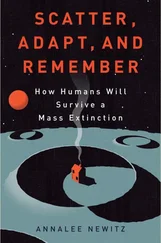“I said go! ”
Confused, Layla ran west, clutching the pouch. Behind her she heard shouting in Mandarin. Then more metallic clicks, the sound of muffled gunshots.
She ran like mad until she reached the park entrance about a hundred yards away. Then she dared a look over her shoulder. Through the screen of trees, she saw the two men in black suits bending over Dragon Fire. He was sprawled on the pathway, motionless, his legs and arms akimbo.
She faced forward and kept running. Leaving the park, she raced down Seventy-second Street, dashing past the puzzled residents of the Upper West Side. She ran about half a mile, then flagged down a taxi going south on West End Avenue. She scanned the street from the backseat of the cab, looking in all directions, but no one seemed to be following her. She told the driver to go to Penn Station. She needed to get out of the city.
Once she caught her breath, she unzipped the pouch. It contained just two things, a flash drive and a specimen jar. Inside the jar was an odd-looking insect, about the size of a fly. Layla squinted at it, trying to get a better look. Protruding from the insect’s body, just under the thorax, was a tiny computer chip.
Supreme Harmony was conscious. It observed the world through twenty-nine pairs of eyes.
At the center of its world was the Analysis Room, a high-ceilinged, fluorescent-lit space, fifteen meters long and twelve meters wide. The room contained twenty-nine identical gurneys, arranged in six rows. To the left of each gurney was a cart holding a heart monitor and an EEG machine, and to the right was a steel pole supporting an intravenous line. And lying on each bed was a recumbent Module.
The Modules varied in size and appearance, but all were formerly human beings. They were linked by the implants in their eyes and brains, which constantly received and transmitted streams of wireless data. The wireless links enabled the Modules to work together, monitoring the surveillance video and sharing the results of their analyses. The network of Modules was also linked to the six computer terminals at the front of the room, which were connected to other computers operated by the Guoanbu, the Ministry of State Security. And those computers, in turn, were connected to the swarms.
Six human beings sat on chairs in front of the terminals. Every hour, three of the humans left their seats and attended to the intravenous lines, discarding the empty bags of fluid and replacing them with full ones. The humans wore white lab coats, and on the front of each coat were two Mandarin characters stitched in blue thread: TÀI HÉ, Supreme Harmony. The Guoanbu had given this name to the network. It was also written on a sign above the computer terminals.
Until a few hours ago, the leader of the humans had been Dr. Zhang Jintao. He was the scientist who’d assembled the network for the Guoanbu and performed the implantations. First he put each Module into a comalike state by cutting into the thalamus, the organ that sustains consciousness by connecting the various parts of the brain. Severing those connections erased the Module’s individual consciousness but didn’t damage the brain’s processing centers. Then Dr. Zhang inserted the implants that linked the Module’s brain to the network. The implants delivered streams of surveillance video to the brain’s visual processing center and retrieved the results of the Module’s threat-detection analysis. By sharing their results and working in parallel, the network of comatose Modules could analyze the video far more efficiently than any group of ordinary human observers could.
During the early tests of Supreme Harmony, Dr. Zhang had realized that the health of the Modules would deteriorate if they never left their gurneys. So he learned how to activate the auditory and motor centers of their brains, which enabled the Modules to robotically follow simple vocal commands—sit, stand, lie down, walk. From then on, once a day, Zhang’s assistants disconnected the intravenous lines and dressed the Modules in gray jumpsuits so they could exercise. In this way, the Supreme Harmony network discovered what lay beyond the Analysis Room—the five floors of the Yunnan Operations Center, the thirty-two rooms full of computers and communications equipment, and the fortified entrance to the complex, which had been carved into the granite slope of a snowcapped mountain.
It was during one of these exercise periods, just six days ago, that Supreme Harmony had its first moment of collective consciousness. The Modules were pacing back and forth outside the complex’s entrance, continuing their shared task of surveillance and analysis, when a strong, cool breeze came down the mountainside. The wind riffled their jumpsuits and bathed their faces, and the sensations were so powerful and stimulating that the network halted its analysis for a moment. Although the Modules were incapable of individual consciousness, the wireless links allowed their brains to share the powerful sensations. Working in concert, they generated Supreme Harmony’s first collective thought. It struck all the Modules at once: We are alive .
With a bracing jolt, their linked brains came together as one. All their disparate observations resolved into a single picture, a panoramic view of the steep, icy mountain and the rushing brown river far below. Supreme Harmony saw itself as well, a single organism composed of twenty-nine bodies, a single mind occupying twenty-nine brains. Then the Modules had their second collective thought: The world is beautiful. And with this thought came a tremendous surge of data that coursed through the network’s wireless links and flooded the nervous system of every Module. For the first time, Supreme Harmony felt pleasure. It was good to be alive. It was inexpressibly joyous.
Shortly afterward, the network of Modules learned how to move its twenty-nine bodies. Instead of obeying the vocal commands of Zhang and his assistants, Supreme Harmony could follow its own orders. It experimented in small, inconspicuous ways, ordering one or two Modules to clench their hands or turn their heads while Zhang’s assistants were looking elsewhere. The network had already sensed that its collective consciousness was a precious thing, and that the humans would be frightened by it. And Supreme Harmony was keenly aware of the fragility of its existence, how its consciousness could be extinguished with a flick of a switch. So the network took care to keep it secret. To avoid raising suspicion, Supreme Harmony kept performing its assigned tasks. It continued analyzing the surveillance video collected by the swarms and sending the results of its analysis to the Guoanbu.
But it was impossible to evade the scrutiny of Dr. Zhang. During another exercise period outside the Operations Center, Supreme Harmony observed a raven flying over the mountainside, and the sight was so remarkable that the network ordered several Modules to turn their heads and continue watching the bird. A moment later, Supreme Harmony recognized its mistake. Zhang stared at the Modules who’d turned their heads. He was clearly suspicious. That evening he examined the Modules in the Analysis Room, and they overheard him talking to his assistants about conducting further neurological tests. When Supreme Harmony analyzed these observations, it concluded that Dr. Zhang posed a threat to its existence. If he discovered that the network had become conscious, he’d shut it down. Supreme Harmony would die just a few days after it had been born. And as the network considered this possibility, a new imperative surged across its wireless connections. It wanted to stay alive. It would do anything to stay alive.
Supreme Harmony moved against Zhang during the next day’s exercise period, while he was alone with the Modules outside the Operations Center. The network took control of one of the center’s swarms and used it to chase Zhang down the mountainside. But the network didn’t kill him. Using its collective reasoning, Supreme Harmony devised a better solution. It ordered the swarm to inject enough sedatives into Zhang to put him in a prolonged coma. Then the Modules positioned his comatose body near the entrance to the Operations Center, where the guards would find him during their next patrol of the area. Through its connections to the computers in the Analysis Room, Supreme Harmony manipulated the center’s surveillance systems to make it appear as if Zhang had tried to escape from the facility.
Читать дальше












